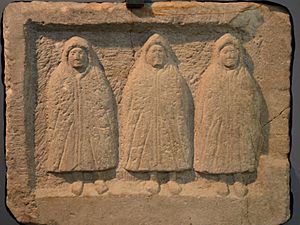Hooded Spirits facts for kids

Have you ever heard of ancient spirits that wore hoods? The Hooded Spirits, also known as Genii Cucullati, were mysterious figures from long ago. People carved their images in stone across the Roman Empire, especially in places like Roman Britain and the Rhineland. These carvings often show them as small, cloaked figures. In Britain, they were often shown in groups of three, like a triple deity.
What's in a Name?
The name Cucullati comes from an old word, cucullos. This word meant 'hood' in the Gaulish language, which was spoken by the Celts. The Romans later used a similar word, cucullus, also meaning 'hood'. Many modern words for hoods, like 'cagoule', come from these ancient terms.
Ancient Beliefs
The hooded cape was a special symbol for the Gauls or Celts during the Roman period. There was even a hooded god of health called Telesphorus. He might have been a mix of Greek and Celtic beliefs from long ago.
We don't know exactly what these Hooded Spirits meant to people back then. This is because no written messages or signs have been found with their carvings in Britain. However, some clues suggest they might have been spirits of good luck or fertility. This means they could have been linked to growing crops or having healthy families.
Interestingly, some of these figures also seem to carry small swords or daggers. This makes some experts think they might have also been part of warrior groups or beliefs. It shows that their meaning might have been quite varied.
Some experts, like Guy de la Bédoyère, warn us not to guess too much about the figures. For example, if one figure is a bit bigger, it might just be how the carver made it. Carving hooded figures was quite easy for artists back then.
See also
- Priapus
- Pisky
- Telesphorus (mythology)

